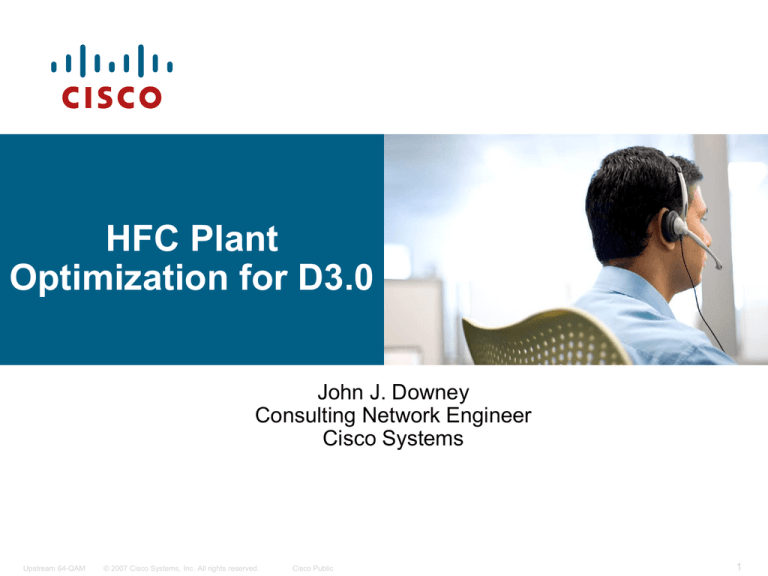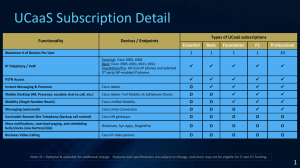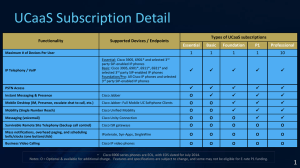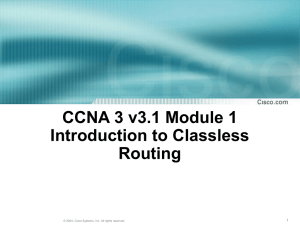
HFC Plant
Optimization for D3.0
John J. Downey
Consulting Network Engineer
Cisco Systems
Upstream 64-QAM
© 2007 Cisco Systems, Inc. All rights reserved.
Cisco Public
1
ATDMA General Deployment Recommendations
After increasing channel width to 6.4 MHz, measure &
document US MER (unequalized would be best)
– 25 dB or higher Unequalized MER is recommended
– Check US MER as well as per CM MER
Document unequalized MER with test equipment at multiple
test points in plant
– PathTrak Return Path Monitoring System linecard
– Sunrise Telecom Upstream Characterization toolkit
– Trilithic
Pick freq < 30 MHz away from diplex filter group delay
Turn on Pre-Equalization
– Can exclude specific Mac or OUI
Upstream 64-QAM
© 2007 Cisco Systems, Inc. All rights reserved.
Cisco Public
2
US MER(SNR) Issues
Increasing ch width keeps same average power
– Doubling ch width will drop MER by 3 dB or more
Equalized vs unequalized MER readings
Modulation profile choices
– QPSK for maintenance, 64-QAM for Data, 16-QAM for VoIP?
– Max output for 64-QAM is 54 dBmV
Cab up n power-adjust continue 6
Pre-EQ affect
– Great feature in 1.1 & > CMs, but could mask issues
Upstream 64-QAM
© 2007 Cisco Systems, Inc. All rights reserved.
Cisco Public
3
44
Pre-EQ
Upstream 6.4 MHz bandwidth 64-QAM signal
Before Adaptive EQ:
Substantial in-channel tilt caused correctable
FEC errors to increment. CMTS’s reported
US MER (SNR) was 23 dB.
After Adaptive EQ:
DOCSIS 2.0’s 24-tap EQ—was able to
compensate for nearly all in-channel tilt (with
no change in digital channel power). Result:
No correctable or uncorrectable FEC errors
and the CMTS’s reported US MER (SNR)
increased to ~36 dB.
Upstream 64-QAM
© 2007 Cisco Systems, Inc. All rights reserved.
Cisco Public
4
Post-Deployment Troubleshooting
MER per US with ability to drill-down for per-CM MER
Use US monitoring tools like PathTrak or Cisco Broadband
Troubleshooter (CBT) to view 5-65 MHz for laser clipping
– Need analyzer to read < 5 MHz for AM or ham radio ingress
– New PathTrak card reads 0.5 MHz - 85 MHz & MacTrak
Cable Flap List monitoring for US or CM issues
Uncorrectable/Correctable FEC per US with ability to drilldown for per-CM counters
Bottom line is correctable & uncorrectable FEC
– If correctable FEC is incrementing, then eventually it will lead to
uncorrectable FEC, which equals packet drops
Upstream 64-QAM
© 2007 Cisco Systems, Inc. All rights reserved.
Cisco Public
5
6
CBT Display
Upstream 64-QAM
© 2007 Cisco Systems, Inc. All rights reserved.
Cisco Public
6
Impairment Increase vs Reporting
CNR
MER(SNR)
Corr FEC
Uncorr FEC
AWGN
Bad
Bad
Bad
Eventually Bad
CW Carrier
Bad
Ok
Ok
Ok
Impulse Noise /
Laser Clipping
Bad
Ok
Ok
Bad
Group Delay /
MicroReflections
Ok
Bad
Bad
Eventually Bad
• Ingress cancellation will cancel some CPD
• CPD resembles AWGN when all DSs are digital
Upstream 64-QAM
© 2007 Cisco Systems, Inc. All rights reserved.
Cisco Public
7
Pre-eq Coeff Direct Load
CMs that drop > 3 dB MER in one SM period get direct load
CMTS support for Type 9 TLVs for DOCSIS 2.0 &> CMs
DOCSIS 1.1 CMs in this state re-register
Following message types added to "sh cab modem verbose"
– Pre-Equalization Counters : 1205 good, 0 scaled, 24 impulse
– Equalizer Coeffs Direct Load : 1 direct coeff loads
• Significant change in freq response may create scaled count
• When CMTS decides to return CM’s EQ taps to known state
without direct load, an impulse value is sent
• Each time Type 9 TLV is sent to CM, direct load counter will
increase by 1
• When CM goes offline, counters are zeroed
Upstream 64-QAM
© 2007 Cisco Systems, Inc. All rights reserved.
Cisco Public
8
Determining per-CM Pre-EQ Taps
Poll pre-eq tap MIB directly from CM:
– Raw values polled to determine red, yellow, green
Cablelabs Proactive Network Maintenance (PNM)
Charter’s “Node Slayer”
Comcast has “Scout Flux”
Upstream 64-QAM
© 2007 Cisco Systems, Inc. All rights reserved.
Cisco Public
9
D3.0 US Issues
Frequency Stacking Levels
– What is the max output with multiple channels stacked
– Is it pwr/Hz & could it cause laser clipping?
Diplex Filter Expansion to 85 MHz
– If amplifier upgrades are planned for 1 GHz, then pluggable diplex
filters may be warranted to expand to 85 MHz on the US
– Still must address existing CPE equipment in field & potential overload
– RFoG could be perfect scenario (maybe even 200 MHz split)
CM must be w-online (requires 1.1 cm file) for US bonding
Monitoring, Testing, & Troubleshooting
– Just like DOCSIS 2.0, test equipment needs to have D3.0 capabilities
Upstream 64-QAM
© 2007 Cisco Systems, Inc. All rights reserved.
Cisco Public
10
US Frequency and Level Issues
Freq assignments
– 5 to 42, 55, 65, 85 MHz ?
Diplex filters, line EQs, step attenuators, CPE overload
Max Tx for D2.0 64-QAM for 1 ch is 54 dBmV
D3.0 US single ch max power
– 57 dBmV (32 & 64-QAM)
– 58 dBmV (8 & 16-QAM)
– 61 dBmV (QPSK)
Max Tx per ch for 4 freqs stacked at 64-QAM ATDMA is
only 51 dBmV & 53 for S-CDMA
– When stacking, level will not change unless max is reached
Upstream 64-QAM
© 2007 Cisco Systems, Inc. All rights reserved.
Cisco Public
11
Channel Placement
Each US channel used for bonding is individual channel
Transmitters (channels) are separate
– Can have different settings; modulation, ch width, tdma or scdma, etc.
Frequencies do not need to be contiguous
Wise to keep relatively close so attenuation and tilt don’t
cause issues
CMs have some dynamic range to allow few dB difference
between channels
Upstream 64-QAM
© 2007 Cisco Systems, Inc. All rights reserved.
Cisco Public
12
Sample Upstream Spectrum Usage
Euro
Split
Upstream 64-QAM
#
From
To
BW
Modulation
Style
Primary
Usage
10
61.4
64.6
3.2
64-QAM
ATDMA
D3.0
9
54.8
61.2
6.4
64-QAM
ATDMA
D3.0
8
48.2
54.6
6.4
64-QAM
ATDMA
D3.0
7
41.6
48
6.4
64-QAM
ATDMA
D3.0
6
35
41.4
6.4
64-QAM
ATDMA
D3.0 & 2.0
5
28.4
34.8
6.4
64-QAM
ATDMA
D3.0 & 2.0
4
23.6
26.8
3.2
16-QAM
TDMA
D1.x
3
20.2
23.4
3.2
QPSK
TDMA
D1.0 DSG
2
13.6
20
6.4
64-QAM
SCDMA
D3.0
1
7
13.4
6.4
64-QAM
SCDMA
D3.0
© 2007 Cisco Systems, Inc. All rights reserved.
Cisco Public
TV IF
13
Total Power
Was only one US ch, now up to 4 chs Txing at same time
– Possibly 6.4 MHz each; nearly 26 MHz US channel loading
Lots of power hitting US laser
Probability of laser clipping is increased, especially if using
legacy Fabry-Perot (FP) lasers
– Distributed Feedback (DFB) lasers have more dynamic range
Use US monitoring system capable of looking above 42
MHz to see second and third order harmonics
Any burst noise above diplex filter (i.e. 42 MHz) coming out
of return path receiver is usually indicative of laser clipping
Upstream 64-QAM
© 2007 Cisco Systems, Inc. All rights reserved.
Cisco Public
14
Laser Clipping
Noise above ~40 MHz (~65 MHz in a Euro-DOCSIS
network) is most likely caused by laser clipping
Upstream 64-QAM
© 2007 Cisco Systems, Inc. All rights reserved.
Cisco Public
15
Laser Clipping
Blue trace shows case of strong laser clipping
Green line represents flat US laser noise floor with no clipping
Note that this US has four US bonded channels
Upstream 64-QAM
© 2007 Cisco Systems, Inc. All rights reserved.
Cisco Public
16
Laser Clipping Artifacts
• 1.5 MHz AM causing Laser
Clipping
• Possibly getting in at power
insertion port of node
Upstream 64-QAM
© 2007 Cisco Systems, Inc. All rights reserved.
Cisco Public
17
US Load Balance & Isolation Example
CMTS US0
@ 24 MHz
4-Way
Fiber Optic
Rx 1
Filter
CMTS US2
@ 31 MHz
Amplifier
4-Way
Fiber Optic
Rx 2
CMTS US1
@ 24 MHz
Attempting to “share” one US port across two other US ports
– Can cause isolation issues
– Load balance issues (ambiguous grouping)
– Low Tx CM in HE/field can overcome isolation and show up on wrong ports
Exacerbated with wide-open power adjust continue window
Note: D3.0 CMs in mtc-mode do not load balance on US
Upstream 64-QAM
© 2007 Cisco Systems, Inc. All rights reserved.
Cisco Public
18
System Levels Reverse
• 17 dB at 5 MHz & 32 dB at 1 GHz
• Eliminates max transmit CMs
CS(CEQ) tap
• Eliminates high DS tilt to TV
26
350’
1.5 dB
23
500’
2
17
FEQ
w/ US
pad
600’
2.5
Input 17
Reverse 43 dBmV
transmit
level @ the tap
42
39.5
PIII .5” cable
.40 dB @ 30 MHz
A total design variation of ~14 dB!
Upstream 64-QAM
© 2007 Cisco Systems, Inc. All rights reserved.
Cisco Public
4
Step
Attenuator
or EQ tap
29
X 38
• Less noise from low value
taps
• Reduces potential “bleedover”/ isolation issues
• Note: pad creates grp
delay at cutoff , whereas
EQ does not
19
Transmit Level Possibilities
Running D3.0 CM in low mod scheme allows higher power
Use D3.0 CM in 2.0 mode
– Single frequency on D3.0 CM offers 3 dB higher power
Minimum level of 20 dBmV could cause issues in lab or HE test CM
– Pmin = +20 dBmV, 2560 ksym/s
– Pmin = +23 dBmV, 5120 ksym/s
Sample ATDMA Mod Profile
Upstream 64-QAM
© 2007 Cisco Systems, Inc. All rights reserved.
Cisco Public
20
US Summary
Targeted insertion of D3.0
– Leverage existing US chs while adding more US capacity
– Load balance 1.x/2.0 and enable D3.0 when needed
Leverage D3.0 bonding for D2.0 tiers & services
– Better stat-mux efficiency
Account for phy connectivity, not just ch capacity
– Not advantageous to combine noise to satisfy connectivity
Fix Max Tx issues now
– Design for tight “bell-curve” (43-48 dBmV), if possible
Good News – ECR to increase US Tx levels
– 61 dBmV max, with 3 dB typical
Upstream 64-QAM
© 2007 Cisco Systems, Inc. All rights reserved.
Cisco Public
21
Reasons CM Does Not Bond on Intended USs
CM not in w-online mode or maybe using 1.0 cm file
Mtc-mode off
Mtc-mode required-attribute & no attribute in cm file
No BG configured or incorrect fiber node config
CM not set for bonding or firmware issue
All US chs not “sta”
– US(s) shut
– Max or Min Tx issues
– Poor MER, plant issues, mis-wired
Oversubscribed CIR
– Call signaling (nRTPS), min US guaranteed speed,
– Could have multiple single ch bonding groups
Note: US service flows like UGS & RTPS assigned to single ch bonding
Upstream 64-QAM
© 2007 Cisco Systems, Inc. All rights reserved.
Cisco Public
22
DS Questions & Potential Concerns
Why it’s Needed
– Competitive pressure, offering higher tiers of service, more customers
signing up
Frequency Stacking Levels & Placement
– What is the e-qam max output with four channels stacked
– Do channels have to be contiguous?
Isolation Concerns
– Applications w/ different service grps lead to overlaid networks
– Signals destined for one node could “bleed” over to another
DS Frequency Expansion to 1 GHz
– Amplifier upgrades are occurring now. It’s best to make the truck roll
once, so think about diplex filters, spacing, taps, etc.
Upstream 64-QAM
© 2007 Cisco Systems, Inc. All rights reserved.
Cisco Public
23
Impairments That Could Affect DOCSIS 3.0
Isolation
Off-air Ingress
Attenuation
Freq assignments
– Spectrum allocation
– Plant limits
Upstream 64-QAM
© 2007 Cisco Systems, Inc. All rights reserved.
Cisco Public
24
Difficult Architecture for Narrowcast
CMTS
DS 0
US 0
LC US 1
1x4 US 2
US 3
• Optical splits create large service group (SG) sizing
• Small narrowcast area or big mxn domain for large SG?
Small narrowcast area = small targeted area, but costly
node splits
Large SG = better stat muxing & sharing, but more
spectrum needed
25
Upstream 64-QAM
© 2007 Cisco Systems, Inc. All rights reserved.
Cisco Public
M-CMTS = 100 Mbps Service Tier
Frequency
• 4 DS freqs
• 2 US freqs
B
Bonding
P
Primary
627
P
P
P
P
P
621
615
P
B
P
P
B
P
P
B
P
P
B
P
P
B
P
609
P
P
P
P
P
Bonding
across 4
freqs & 4-ch
load
balance for
legacy CMs
16-QAM
64-QAM
28
TDMA
22
ATDMA
3.2 MHz
6.4 MHz
FN1
FN2
FN3
FN4
FN5
FN6
FN7
FN8
FN9
FN10
• 5, 4x4 MAC domains with ATDMA & TDMA USs
• DS connector overlaid for 2 nodes
Upstream 64-QAM
© 2007 Cisco Systems, Inc. All rights reserved.
Cisco Public
26
DOCSIS 3.0 DS Considerations
Frequency assignments
–
–
–
–
CMTS may be limited to 860 MHz or 1 GHz
Legacy CMs (1.x & 2.0) limited to 860 MHz bandedge
E-qam limited to contiguous 24 MHz or 4 channel slots
CMs may be limited to 50 or 60 MHz passband
M-CMTS architecture requires DTI and local USs
– Distance limitation, time offset differences, level differences
Resiliency is another topic to address
– If one DS frequency goes bad in field, how do CMs recover or react?
E-qam licensing?
CM requires 1.1 config file
Upstream 64-QAM
© 2007 Cisco Systems, Inc. All rights reserved.
Cisco Public
27
DOCSIS 3.0 DS Considerations (cont)
More DS = more US
Testing and maintaining multiple DS channels
– Physical chs have not changed for DOCSIS 3.0
– Test equip with built-in CMs need to support bonding
• May need to exclude from LB and other feature like pre-eq
DS ch bonding max power with 4 freqs stacked
– Four chs stacked on 1 connector limited to 52 dBmV/ch
• DOCSIS 1.x/2.0 DS is 61 dBmV max output
DS isolation issues
Upstream 64-QAM
© 2007 Cisco Systems, Inc. All rights reserved.
Cisco Public
28
M-CMTS, DS Overlay and Isolation Issues
DSs 0-3 = 603 MHz
Overlay = 609, 615 & 621 MHz
DS 0
Potential Isolation Path
DS Combiner
DS 1
DS Tx
E-QAM with DTI
DS Licensing?
Contiguous QAMs?
Level granularity?
DS 2
Load balance between local & remote
DSs could have timing issues
DS 3
Edge-QAM
Upstream 64-QAM
© 2007 Cisco Systems, Inc. All rights reserved.
Cisco Public
29
Isolation Amp
W
• Can this device handle 50 dBmV input with 4-8 ch loading?
Upstream 64-QAM
© 2007 Cisco Systems, Inc. All rights reserved.
Cisco Public
30
Design Rules & Restrictions
D3.0 spec goes to 1 GHz, some equipment may not
D3.0 CM spec requires 60 MHz capture window
DPC3000 capture of 96 MHz over most spectrum
– 82 MHz max window supported over entire spectrum
TI 4x4 CM (60 MHz window)
Brcm 8x4 CM (2, 32 MHz bands or 1, 96 MHz band)
– DS freqs must be contiguous within tuner block unlike 4x4 CMs
– Can use RCC templates to setup both tuners
– New feature called Split Tuner creatse 2 Rx modules and moves tuners
automatically without RCC templates
Put voice call service flows on a primary DS
– cable docsis30-voice downstream req-attr-mask 0 forb-attr-mask 80000000
Upstream 64-QAM
© 2007 Cisco Systems, Inc. All rights reserved.
Cisco Public
31
DS Summary
Targeted insertion of D3.0
– Leverage existing US chs while adding more DS capacity
– Load balance 1.x/2.0 and enable D3.0 when needed
Leverage D3.0 bonding for D2.0 tiers & services
– Better stat-mux efficiency & improved consumer experience
Enable seamless upgrade to higher D3.0 tiers
– Wire once & add QAM chs as tiers or service take-rates go up
Can also disable DS bonding
– No cable mrc-mode
– Per-CM exclude with vendor specific MIB or TLV
Upstream 64-QAM
© 2007 Cisco Systems, Inc. All rights reserved.
Cisco Public
32
What Does This Bandwidth Graph Represent?
Mbps
38
37
36
35
34
33
32
31
30
29
28
27
26
25
24
23
22
21
20
Time
Upstream 64-QAM
© 2007 Cisco Systems, Inc. All rights reserved.
Cisco Public
33
10 Points to Ponder
1. Many speed sites report at layer 3 of OSI model
– Configure cm file for 5-10% higher than marketed
2. No control over actual frame size (64-1518 B)
– Frame size overhead 18/64 (28%) vs 18/1518 (1.2%)
– MTU affected by wireless, VPN, ….
3. Small frames = small DOCSIS pipes
– Only 35 Mbps when all frames are DS VoIP of 229 B
4. PowerBoost™ can give perception of greater speed
– Could cause issues when deciding to do node splits
– How to control peak rate
Upstream 64-QAM
© 2007 Cisco Systems, Inc. All rights reserved.
Cisco Public
34
10 Points to Ponder (cont)
5. DS TCP requires US acks
–
–
US pipe could slow down DS speed tests
Small US acks make US pipe worth less
• DOCSIS overhead usually 11 B per frame
• 10.24 Mbps raw = 9 Mbps usable, but only 7.5 with acks!
6. More frames = more PPS = higher CPU usage
–
–
At some point CPU in modem could (will) be bottleneck
TCP (typically 2 DS per 1 US ack)
7. During congestion, you still want priority for VoIP signaling,
maybe video acks, and CM registration
8. Load balancing is good, but what speed tier pushes
customer to bonding?
– Maybe >50% of linerate
Upstream 64-QAM
© 2007 Cisco Systems, Inc. All rights reserved.
Cisco Public
35
10 Points to Ponder (cont)
9. Netflix/Hulu TV are using ABR, which is TCP-based
–
–
–
–
Will cause US traffic in form of acks
New CMs may have ack suppression on by default
Typical US to DS TCP ratio of ~2%
With ack suppression, that can drop below 1%
Ack suppression doesn’t alleviate CM CPU
– DS IP video of 3-7 Mbps and may make ack suppression inefficient
– Implement PHS, but more testing needed
10. Many tweaks needed to get per-CM US speeds > 3 Mbps
–
–
–
–
Lots of concatenation leads to fragmentation
Fragmentation adds headers
Preamble & gaurdtime added to each fragment
D3.0 US bonding can do concatenation and keep < 2000 B
May not require fragmentation, so less overhead
Upstream 64-QAM
© 2007 Cisco Systems, Inc. All rights reserved.
Cisco Public
36
Upstream 64-QAM
© 2007 Cisco Systems, Inc. All rights reserved.
Cisco Public
37









